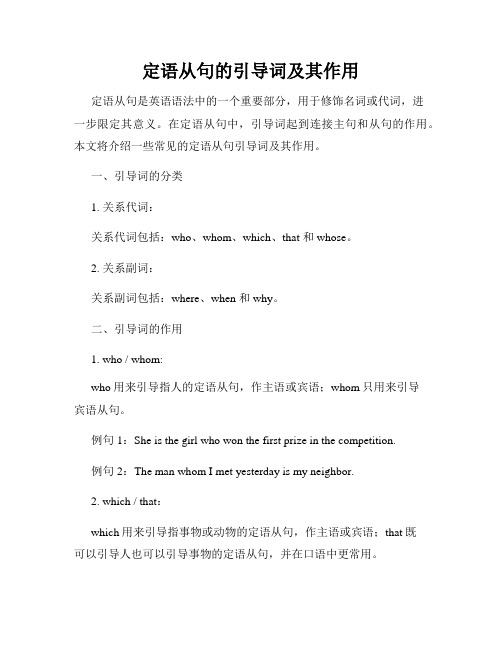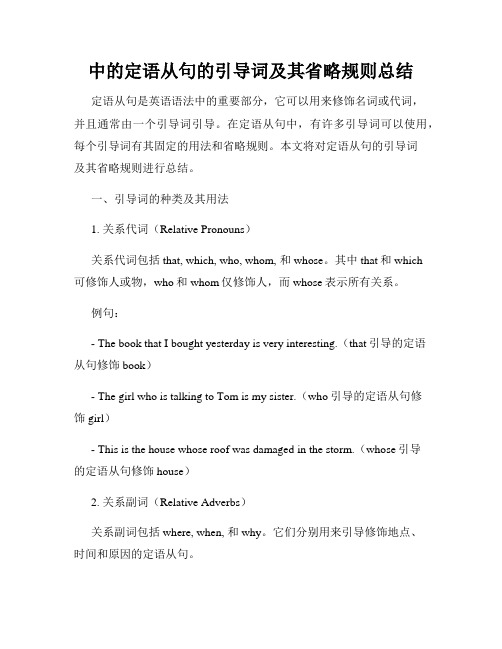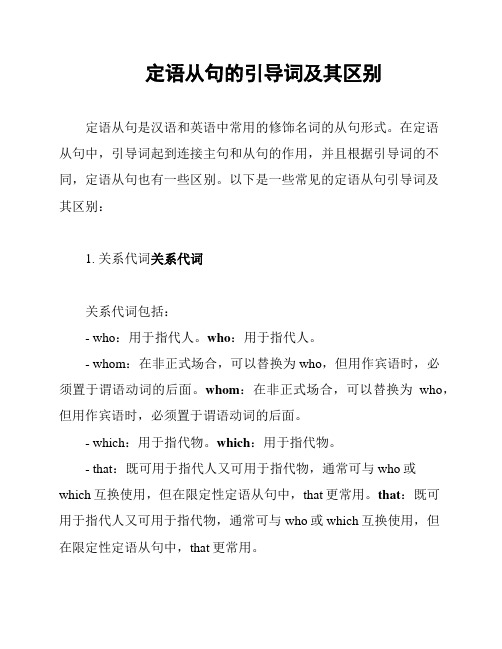定语从句及其引导词用法
定语从句的引导词及其作用

定语从句的引导词及其作用定语从句是英语语法中的一个重要部分,用于修饰名词或代词,进一步限定其意义。
在定语从句中,引导词起到连接主句和从句的作用。
本文将介绍一些常见的定语从句引导词及其作用。
一、引导词的分类1. 关系代词:关系代词包括:who、whom、which、that 和whose。
2. 关系副词:关系副词包括:where、when 和why。
二、引导词的作用1. who / whom:who用来引导指人的定语从句,作主语或宾语;whom只用来引导宾语从句。
例句1:She is the girl who won the first prize in the competition.例句2:The man whom I met yesterday is my neighbor.2. which / that:which用来引导指事物或动物的定语从句,作主语或宾语;that既可以引导人也可以引导事物的定语从句,并在口语中更常用。
例句3:This is the book which/that I am reading.例句4:The car that/which he bought last week is very expensive.3. whose:whose用来引导定语从句,表示所属关系,修饰名词或代词。
它在从句中充当定语从句的成分。
例句5:The girl whose bag was stolen reported it to the police.4. where:where用来引导表示地点的定语从句,修饰名词或代词。
它在从句中充当定语从句的成分。
例句6:This is the school where my parents studied.5. when:when用来引导表示时间的定语从句,修饰名词或代词。
它在从句中充当定语从句的成分。
例句7:The day when we met was memorable.6. why:why用来引导表示原因或理由的定语从句,修饰名词或代词。
英语中定语从句的用法

定语从句是一种英语语法结构,用于修饰名词或代词,说明其性质或特征。
以下是定语从句的主要用法:
1. 引导词:定语从句由引导词引导,常用的引导词有that、which、who、whose、whom、where、why等。
2. 关系词:关系词在定语从句中作为替代词,代表被修饰的名词或代词。
关系词分为关系代词和关系副词。
关系代词有who、whom、whose、that、which等,关系副词有where、why、how等。
3. 限定性定语从句和非限定性定语从句:限定性定语从句对所修饰的名词或代词进行限定,使句子意思更加明确。
而非限定性定语从句则是对所修饰的名词或代词作进一步的描述或解释,通常用逗号与主句隔开。
4. 介词+关系代词:在定语从句中,介词+关系代词的结构常常引导定语从句。
常用的介词有in、on、by、to等。
5. 省略引导词:在口语和书面语中,有时可以省略引导词。
但在正式文体中,通常需要保留引导词。
总的来说,定语从句是英语语法中的一个重要组成部分,它可以增强句子的表达效果和准确性。
在使用定语从句时,需要注意语法规则和表达习惯,以确保句子通顺、流畅。
中的定语从句的引导词及其省略规则总结

中的定语从句的引导词及其省略规则总结定语从句是英语语法中的重要部分,它可以用来修饰名词或代词,并且通常由一个引导词引导。
在定语从句中,有许多引导词可以使用,每个引导词有其固定的用法和省略规则。
本文将对定语从句的引导词及其省略规则进行总结。
一、引导词的种类及其用法1. 关系代词(Relative Pronouns)关系代词包括that, which, who, whom, 和whose。
其中that和which可修饰人或物,who和whom仅修饰人,而whose表示所有关系。
例句:- The book that I bought yesterday is very interesting.(that引导的定语从句修饰book)- The girl who is talking to Tom is my sister.(who引导的定语从句修饰girl)- This is the house whose roof was damaged in the storm.(whose引导的定语从句修饰house)2. 关系副词(Relative Adverbs)关系副词包括where, when, 和why。
它们分别用来引导修饰地点、时间和原因的定语从句。
例句:- I still remember the day when we first met.(when引导的定语从句修饰day)- This is the village where my grandparents were born.(where引导的定语从句修饰village)- I don't know the reason why he didn't come.(why引导的定语从句修饰reason)二、引导词的省略规则在定语从句中,有时可以省略引导词,以避免重复或简化句子结构。
引导词的省略规则如下:1. 当定语从句修饰非人的先行词时,关系代词who和whom可以被省略。
定语从句引导词

定语从句引导词定语从句是英语中一个重要的语法结构,用来修饰名词或代词。
定语从句引导词在句子中起着引导定语从句的作用,有多种形式,包括关系代词和关系副词。
本文将介绍定语从句引导词的用法和例句。
一、关系代词引导的定语从句关系代词引导的定语从句主要有:that, which, who, whom, whose等。
它们分别指代先行词在句子中的不同角色。
1. that关系代词that可指代人或物,在定语从句中作主语或宾语。
例如:- The book that I borrowed from the library is very interesting.- The car that she bought last month is red.2. which关系代词which指代物,在定语从句中作主语或宾语。
例如:- This is the computer which I use for work.- The building which was destroyed in the fire will be rebuilt.3. who关系代词who指代人,在定语从句中作主语。
例如:- The man who is standing over there is my father.- She is the girl who won the singing competition.4. whom关系代词whom指代人,在定语从句中作宾语。
例如:- The student whom the teacher praised is very diligent.- I have a friend whom I can always rely on.5. whose关系代词whose用来表示所属关系,修饰物或人。
例如:- This is the company whose products are well-known worldwide. - The girl whose father is a doctor wants to become a nurse.二、关系副词引导的定语从句关系副词引导的定语从句主要有:where, when, why等。
定语从句引导词的用法

定语从句引导词的用法
一、that的用法
1 、在定语从句中,that 引导的定语从句,在句中作宾语或状语。
① 作宾语:
We discussed something about the plan 〔that〕we thought was realistic.
我们讨论了一些我们认为现实可行的关于计划的事情。
他工作很努力,几乎未能把所有工作做完。
2、在含有介词的定语从句中,that 几乎不用,介词后面直接接定语从句。
这就是她从哪里获得资金的原因。
他找到了他要找的钥匙。
这就是她曾经工作的那栋建筑物。
三、whose的用法
1、whose 引导定语从句,其意思是“…的”,它只能指人,一般在句中作定语。
头发乱糟糟的女孩走进了房间。
2、whose 也可以替代 of which 来引导定语从句,但只能用于某些句型中。
He is the teacher 〔whose〕books I read.
他就是我读过书的老师。
定语从句的引导词和构成

定语从句的引导词和构成定语从句是英语中非常常见的一种从句类型,用来修饰名词或代词。
定语从句可以通过引导词来引导,同时在构造上也需要一定的规则。
本文将介绍定语从句的引导词和构成形式。
一、定语从句的引导词定语从句可以由多种引导词引导,常见的引导词有:1. 关系代词:关系代词用来引导定语从句,并在从句中代替被修饰的名词。
关系代词包括:who, whom, whose, which, that。
例如:The girl who is sitting next to me is my sister.(坐在我旁边的女孩是我的姐妹。
)2. 关系副词:关系副词用来引导定语从句,并在从句中充当状语。
关系副词有:when, where, why。
例如:I still remember the day when I first met him.(我仍然记得我第一次见到他的那天。
)3. 关系代词+ever:由关系代词加上ever构成的引导词,用来引导不定性定语从句。
例如:You can take whichever book you like.(你可以拿任何你喜欢的书。
)二、定语从句的构成定语从句可以由主系结构和非主系结构构成。
1. 主系结构:即关系代词或关系副词作为主语、宾语或表语。
例如:I bought the book that was recommended by my teacher.(我买了老师推荐的那本书。
)2. 非主系结构:即关系代词或关系副词与介词结合构成介词短语,在定语从句中作状语。
例如:The house where he used to live is now a museum.(他过去住的那座房子现在是一个博物馆。
)三、定语从句的用法定语从句一般用来修饰名词或代词,起到进一步说明或限定的作用。
定语从句通常位于被修饰名词之后。
例如:The car that is parked outside is mine.(停在外面的那辆车是我的。
定语从句引导词的用法

(3) which还有一种特殊用法,它可以引 导从句修饰前面的整个主句,代替主句 所表示的整体概念或部分概念。在这种 从句中,which可以作主语,也可以作宾 语或表语,多数情况下意思是与and,this 相似,并可以指人。例如: He succeeded in the competition, which made his parents very happy.
(2) 如果先行词被形容词最高级以及first, last, any, only, few, mush, no, some, very 等 词 修 饰 , 引 导 词 常 用 that, 不 用 which, who,或whom。例如: 1.The first lesson that is very funny. 2.He is the only one person that works very hard.
ห้องสมุดไป่ตู้
(6) 如 果 先 行 词 是 anyone,anybody, everyone,everybody,someone,somebody, 引 导 词 应 该 用 who 或 whom , 不 用 which。例如: 1.Is there anyone here who will go with you?
定语从句——引导词的用法
(1) 如果先行词是all, much, anything, something, nothing, everything, little, none等不定代词,引导词一般只用that, 不用which。例如: 1.All the students that are very happy. 2.Everything that teachers say is very helpful.
定语从句的引导词及其区别

定语从句的引导词及其区别定语从句是汉语和英语中常用的修饰名词的从句形式。
在定语从句中,引导词起到连接主句和从句的作用,并且根据引导词的不同,定语从句也有一些区别。
以下是一些常见的定语从句引导词及其区别:1. 关系代词关系代词关系代词包括:- who:用于指代人。
who:用于指代人。
- whom:在非正式场合,可以替换为who,但用作宾语时,必须置于谓语动词的后面。
whom:在非正式场合,可以替换为who,但用作宾语时,必须置于谓语动词的后面。
- which:用于指代物。
which:用于指代物。
- that:既可用于指代人又可用于指代物,通常可与who或which互换使用,但在限定性定语从句中,that更常用。
that:既可用于指代人又可用于指代物,通常可与who或which互换使用,但在限定性定语从句中,that更常用。
关系代词引导的定语从句通常在从句中作主语、宾语或定语。
2. 关系副词关系副词关系副词是指用来引导定语从句时,在从句中兼具副词和连词功能的词语。
- where:用于指代地点或场所。
where:用于指代地点或场所。
- when:用于指代时间。
when:用于指代时间。
- why:用于指代原因。
why:用于指代原因。
关系副词引导的定语从句通常在从句中作状语。
3. 介词 + 关系代词/副词介词 + 关系代词/副词介词加关系代词/副词构成的短语可以用来引导定语从句,其中常见的有:- in which:表示地点或时间。
in which:表示地点或时间。
- of which:表示归属或来源。
of which:表示归属或来源。
- for whom:表示对象。
for whom:表示对象。
这种结构的定语从句通常在从句中作状语、宾语或定语。
以上是定语从句的引导词及其区别的介绍。
在书写定语从句时,需根据从句的修饰对象选择适当的引导词,并注意引导词的位置和用法。
通过掌握定语从句的引导词及其区别,可以更加准确和流畅地表达自己的意思。
- 1、下载文档前请自行甄别文档内容的完整性,平台不提供额外的编辑、内容补充、找答案等附加服务。
- 2、"仅部分预览"的文档,不可在线预览部分如存在完整性等问题,可反馈申请退款(可完整预览的文档不适用该条件!)。
- 3、如文档侵犯您的权益,请联系客服反馈,我们会尽快为您处理(人工客服工作时间:9:00-18:30)。
一、基本概念: 在复合句中,修饰某一名词或代词的从句叫定语从句。如: Do you know the man who spoke at the meeting just now? That is the house where he lived ten years ago. 定语从句所修饰的词叫先行词;定语从句一般用关系代词或关系副词来引导,关系词放在先行词与定语从句之间起连接作用,同时又作从句中的一个成分。 引导定语从句的关系代词有:that, who, whom, whose, which; 关系副词有:when, where, why.
二、关系词的用法: (一)关系代词的用法: 1. 作主语用who, which和that, 如: He is the man who/that lives next door. The train which/that has just left is for Shenzhen. 2. 作宾语用whom, who, which, that, 如: The man (whom/who/that) we have just seen is a famous writer. Where is the book (which/that) I bought last week? 注:在非正式文体中,用于指人的关系代词who whom, that 通常可以省略,但在正式文体中通常用whom, 不可省略;用于指物的关系代词which和that 在非正式文体中也通常省略,但在正式文体中一般不省略。 3. 作定语用whose, 如: (a) He is the man whose car was stolen last week. (b) It was a meeting whose importance I did not realize at that time. 注:“whose +名词中心词”这一结构在定语从句中既能作主语(如上a句),又能作宾语(如上b句)。whose 的先行词常用来指人,但有时也可以用来指具体事物或抽象概念,这时可以与of which 结构互换,词序是:“名词+of which”,如: They came to a house whose back wall had broken down.. (= the back wall of which) He’s written a book the name of which I’ve completely forgotten. (= whose name) 4. 作表语只用that ,它既可以指人,也可以指物,但时常省略。如: He is no longer the man that he used to be. This is no longer the dirty place (that) it used to be. (二)关系副词的用法: 1.when 指时间,在从句中作时间状语,它的先行词通常有:time, day, morning, night, week, year 等。如: I still remember the time when I first became a college student. Do you know the date when Lincoln was born? 注:when时常可以省略,特别是在某些句型和某些时间状语中。如: Each time he came, he did his best to help us. But help never stopped coming from the day she fell ill. 2.where指地点,在从句中作地点状语。它的先行词通常有:place, spot, street, house, room, city, town, country等,如: This is the hotel where they are staying. I forget the house where the Smiths lived. 注:where有时也可以省略。如: This is the place (where) we met yesterday. 3. why指原因或理由,它的先行词只有reason。如: That is the reason why he is leaving so soon. 注:why时常也可以省略。如: That is the real reason he did i
t. (三) 使用关系副词应注意下列几点: 1. 这三个关系副词在意义上都相当于一定的介词+which结构: when = on (in, at, during…) + which; where = in (at, on…) + which; why = for which. 如: I was in Beijing on the day when (=on which) he arrived. The office where (=in which) he works is on the third floor. This is the chief reason why (=for which) we did it. 2. 当先行词是表时间的time, day等和表地点的place, house等时,一定要注意分析从句的结构,如果缺少主语或宾语时,关系词应该用which或that, 缺少时间状语或地点状语时,才能用when或where,试比较: I’ll never forget the day when my hometown was liberated. I’ll never forget the days which/that we spent together last summer. His father works in a factory where radio parts are made. His father works in a factory which/that makes radio parts. 3. when和where既可以引导限制性定语从句,也可以引导非限制性定语从句。而why 只 能引导限制性定语从句。
三.限制性定语从句与非限制性定语从句 1.限制性定语从句说明先行词的情况,对先行词起限定作用,与先行词关系十分密切,不可用逗号隔开,也不可省略,否则全句意义就不完整。如: This is the telegram which he refers to. Is there anything (that) I can do for you? 2.非限制性定语从句只是对先行词作补充说明,没有限定作用,它与先行词的关系比较松散,因而不是关键性的,如果省略,原句的意义仍然完整。这种从句在朗读时要有停顿,在文字中通常用逗号与主句隔开。如: This note was left by Tom, who was here a moment ago. As a boy, he was always making things, most of which were electric. 引导非限制性定语从句的关系词有:who, whom, whose, which, when 和 where,不可以用that和why。 另外,非限制性定语从句从意义上讲,相当于一个并列句,在口语中使用并不普遍,在日常生活中,人们通常用并列句或简单句来表达。如: I told the story to John, who later did it to his brother. = I told the story to John, and he later told it to his brother. Yesterday I happened to see John, who was eager to have a talk with you. = Yesterday I happened to see John and he was eager to have a talk with you. 3.两种定语从句的内涵不同,限制性定语从句具有涉他性,而非限制性定语从句具有 唯一性,这在理解和翻译时应特别注意。试比较: All the books there, which have beautiful pictures in them, were written by him. All the books there that have beautiful pictures in them were written by him. His brother, who is eighteen years old, is a PLA man. (只有一个) His brother who is a PLA man is eighteen years old. (不止一个) 4.有时,非限制性定语从句所修饰的不是某一个词,而
是整个主句或是主句中的一个部分,这时一般采用which或as来引导。如: He passed the exam, which/as he hoped he would. 注:(1)as引导的从句可以放在主句之前,而which引导的从句只能放在主句之后。 They are hollow, which makes them very light. As is known to all, Taiwan is a part of China. (2)从意义上讲,which指前面主句的内容;而as指代的是作为一般人都知道的常 识性的东西,因此常译成“就象… …那样”。 (3)如果定语从句的内容对主句的内容起消极作用,则用which,而不用as,如: She stole her friend’s money, which was disgraceful. He tore up my photo, which upset me. 5.在正式文体中,以the way为先行词的限制性定语从句通常以in which或 that 引导,如: The way in which you answered the questions was admirable. 但在非正式文体中,人们通常省略in which或 that : The way (in which) he spoke to us was suspicious. I don’t like the way (that) you laugh at her.
